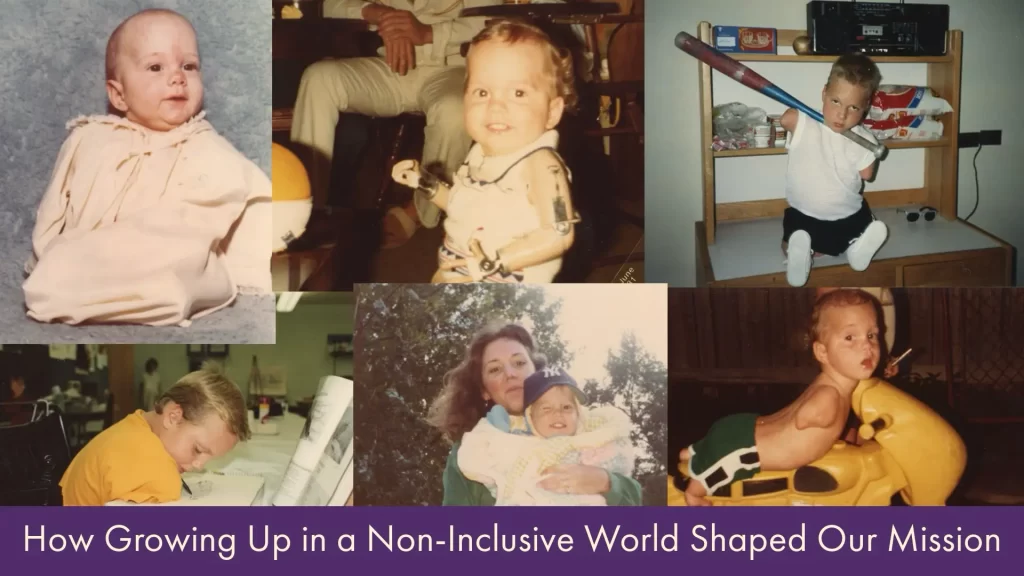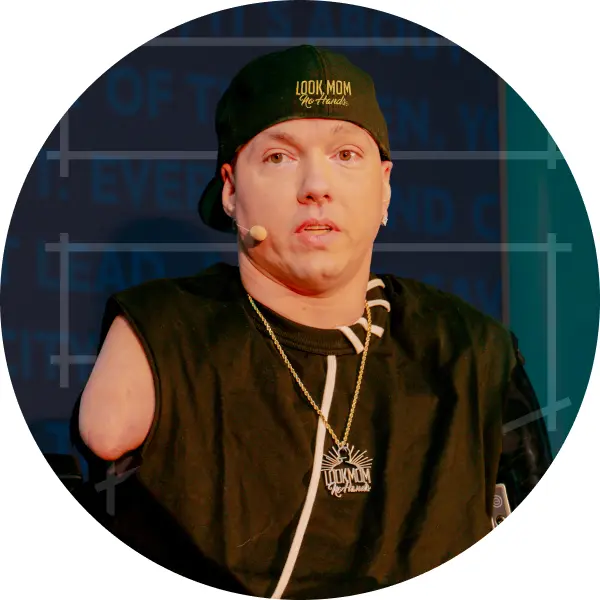Growing up in a non-inclusive world, I faced many obstacles in a world not designed for people in wheelchairs, limb differences, and people with disabilities in general. Every doorway, every event, every public space was a reminder that I didn’t fit into the mold of what society thought was “normal.” I wasn’t alone in this experience—my son, Noah, has had to navigate his own challenges as someone with dyslexia and being a caretaker for a parent with a disability. Together, we’ve lived through enough exclusion and misunderstanding to know one truth deeply: inclusion can’t be an afterthought.
That truth became the driving force behind Equal Accessibility, a company we co-founded to help businesses do more than just meet ADA standards. We’re on a mission to help organizations rethink how they welcome people—how they see people—so that everyone, regardless of their ability, feels like they truly belong in an inclusive world.
The World Wasn’t Built for Us
When I was a kid, my world was filled with compromises. I couldn’t get into most buildings unless someone helped. I had to find creative (and often unsafe) ways to close doors—sometimes having to stick my toe into door jambs just to shut a door. I’d hear other kids talk about sleepovers, concerts, sporting events, or amusement parks, and I knew there was a good chance I wouldn’t be able to join in—or at least not in the same way. These weren’t isolated experiences; they were constant reminders that the world wasn’t designed with someone like me in mind.
Becoming a parent only magnified that frustration. I remember going to events with my kids and being forced to sit away from them because the accessible seating wasn’t anywhere near the rest of the audience. We didn’t get the same shared experience as other families. It was a harsh reality that pushed us toward creating a more inclusive world—not just for ourselves, but for every child and parent who’s ever felt left out.
Inclusion Isn’t Just a Checklist
We live in a society where accessibility is often treated like a checkbox. Install a ramp? Check. Add an elevator? Check. But here’s the thing—true inclusion is about more than physical access. It’s about emotional access. It’s about dignity. It’s about giving people with disabilities the same experiences—not just a “separate but functional” alternative.
At Equal Accessibility, we focus on the emotional and experiential aspects of inclusion. We believe that accessibility accommodations should feel normal, not exceptional. We help organizations recognize the subtle ways they might unintentionally exclude people—things like having separate entrances, isolated seating, or hard-to-navigate websites. These things matter. They shape how people feel, how welcome they are, and whether they want to come back.
Creating an inclusive world means designing with people with disabilities, not just for them.
Representation in Media Matters
Growing up, I didn’t see people like me on television. When you don’t see yourself represented in the media, it reinforces this idea that you don’t belong—or worse, that your story isn’t worth telling. That’s why it was such an incredible honor for me to be featured in a Rocket Super Bowl commercial.
Being part of that moment wasn’t just a personal milestone—it was about visibility. It was about showing people with disabilities, limb differences, and mobility challenges that we do belong in mainstream media, in big brand stories, and on the biggest stage in advertising. The feedback I received afterward—especially from parents of kids with disabilities—was overwhelming in the best way. It reminded me that representation can change lives. It can shift the narrative. It can inspire someone to believe, “If he can do it, maybe I can too.” And that’s one more step toward building an inclusive world.
Our Lived Experience = Our Superpower
Our lived experience is our greatest asset. We know what it feels like to be excluded, overlooked, or even just tolerated instead of embraced. We use that knowledge to create solutions that go beyond compliance and into compassion. From stadiums and hotels to manufacturing plants and retail stores, we’ve helped businesses reimagine their spaces so everyone feels welcome.
When we work with a client, we ask the kinds of questions that only someone who’s been through it would think to ask:
- Can someone close this door easily without fingers or full grip strength?
- Will a family with a disabled child be able to sit together at your event?
- Does your staff know how to interact respectfully with someone who communicates differently?
These are the everyday moments that shape whether someone feels like they’re part of an inclusive world or standing just outside of it.
Why This Matters More Than Ever
In a time where diversity and inclusion are front and center in conversations, disability inclusion is still often left out of the picture. And yet, more than one in four adults in the U.S. lives with some type of disability. That’s a huge segment of the population being underserved.
What’s more—accessibility isn’t just for people who are disabled right now. It’s for the parent pushing a stroller, the athlete recovering from surgery, the aging grandparent who still wants to get around. When you design with inclusion in mind, you’re designing for everyone—because an inclusive world benefits all of us.
From Exclusion to Empowerment
We created Equal Accessibility not just because we wanted to fix broken systems, but because we wanted to build better ones. We wanted to turn our own experiences of exclusion into a roadmap for empowerment—one that others could follow.
The joy that comes from seeing someone light up because they can finally access a building, join an event, or participate fully in an experience—that’s what fuels us. And it all started with the pain of being excluded ourselves.
Building an inclusive world is not just a job for us—it’s our legacy.
A Call to Do More
If you’re a business owner, event planner, architect, or decision-maker, we challenge you to ask yourself: Who am I unintentionally leaving out? Because once you start asking that question, you’ll start seeing the gaps you never noticed before.
And once you see them, you can fix them. That’s where we come in.
Let’s work together to build an inclusive world that works for everyone—because everyone deserves to feel seen, heard, and included.
Contact us today to learn how Equal Accessibility can help you move from compliance to true inclusion.


